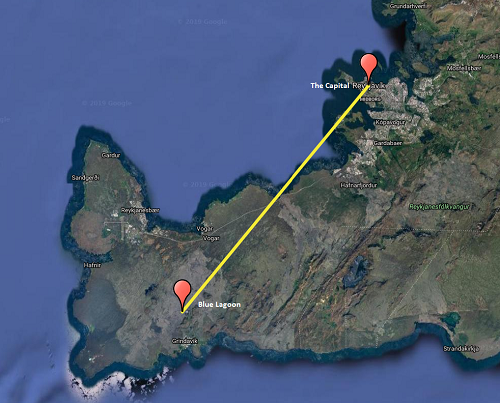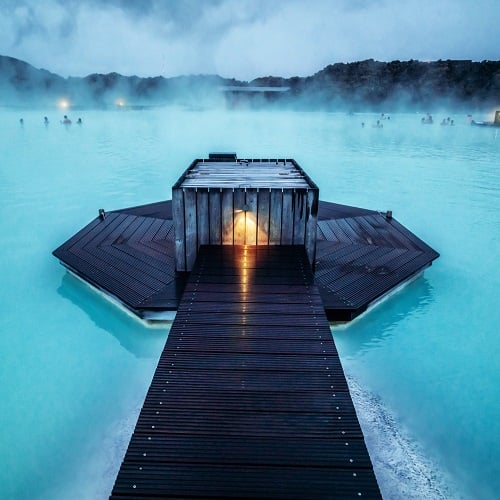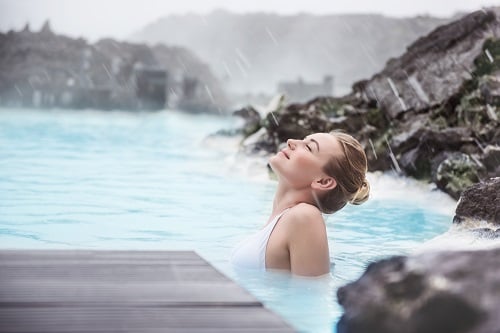Our Guide to the Blue Lagoon
The Blue lagoon made it to the National Geographic’s ‘Top 25 Wonders of the World’ for good reason - it has the perfect bathing temperature of 38-39 degrees all year round set in a stunning location. People from around the globe come to visit this wonder and to soak in its soothing waters.
Below you will find a helpful guide to the Blue Lagoon, exploring how it was made, where it is located and the best time to visit!
What is the history of the Blue Lagoon?
The Blue Lagoon was a happy accident that appeared in 1976 but wasn’t used for its current purpose until 1981. In 1981, a patient with a skin condition called psoriasis noted how his symptoms had been eased after bathing in the blue lagoon waters, ever since then, the waters have gained a reputation for its healing properties.
Although it is the result of a man-made construction, the byproduct of the Svartsengi geothermal power plant, the water is natural and mineral-rich. The waters are light blue milk coloured and this is due to its high silica content. The lagoon is ever-expanding in size and the water completely renews itself every 48 hours.
Where is the Blue Lagoon?
The Blue Lagoon is located on a lava field in Grindavík, on the Reykjanes Peninsula. It is less than an hour’s drive from the capital city, Reykjavik. The best way to get to this geothermal spa is by car. You can park your car in the car park and follow the footpath to the blue lagoon. There are many accommodation options available if you wish to stay overnight, you can book a hotel or an Airbnb to enjoy.

Can you eat at the Blue Lagoon?
After a long soak in the soothing waters of the lagoon, you may build up an appetite for some food. There are a number of restaurants around the lagoon. The Lava and Moss restaurants are very close, there is a Northern Light Inn & restaurant a short drive away also. If you are on a budget there are a number of supermarkets nearby that offer plenty of food options, such as Nettó, Krónan and Bónus.

When is the best time to visit?
The opening times vary, and entry is limited so it is advisable to check when it is open and pre-book. It has longer opening hours in the summer due to the Midnight Sun. The water is the same temperature all year round, so the best time to visit Blue Lagoon is dependent on if you mind it being crowded.
If you want to see the Northern Lights at the Blue Lagoon on your visit then travel during winter. If you want to enjoy the Midnight Sun then go in the summer. Either way, the best time to go is during the evening off-peak time.
Due to the popularity of this attraction, it is somewhat crowded, especially between May-September. However, as previously mentioned, there are limits to entry, so even when fully booked it is not packed.
However, if you wanted to avoid the crowd, then December to January are the calmest months of the year, with Tuesdays and Wednesdays the calmest days of the week. Regarding the time, peak time is between 10am-2pm so hours outside this are advisable for a less crowded experience.

How much does the Blue Lagoon cost?
There are many hot springs in Iceland, and the Blue Lagoon is one of the more expensive geothermally heated pools, this is partly due to its popularity and proximity to Reykjavik.
Entry is free for 2-13-year olds. Under 2-year olds are not permitted.
Adults (14+) entrance fee costs between 6990 ISK (~£44 / $55)(Comfort ticket) to 9900ISK (~£63 / $55)(Premium). The comfort ticket includes entrance fee, silica mud mask, use of a towel and 1 drink. The premium ticket has many extras benefits and the extra 3000 ISK price reflects this.

